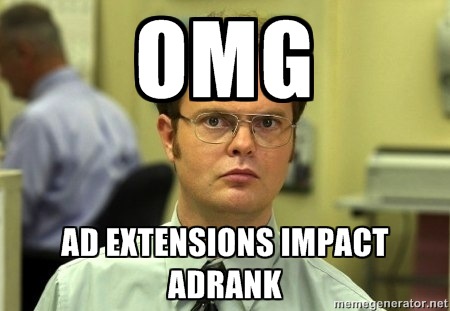
This week, Google announced a significant AdWords update: Ad Rank, the system for ordering competing ads on search results pages, now takes into account the anticipated effect of your ad extensions and formats.
To date, Google has considered only your max CPC and Quality Score as part of the Ad Rank algorithm.
Now, ad extensions and formats play a role in where your ads show on SERPs. The projected effect can be the factor to push you past your competition, if max CPC and Quality Score are equal.
Why the Emphasis on Ad Extensions and Formats?
Google has concentrated heavily on building out ad extensions this year, most recently with the additions of review extensions and image extensions in June, and a mobile-friendly/multi-screen update in August.
Extensions are useful for making ads more useful and interactive; they allow you to share more information in different ways and can make it easier for potential customers to connect. Click to call ad extensions, for example, can be a great thing for local businesses. Google shared research last month that shows 70% of mobile searchers call a business directly from search results.
If you haven’t found a use for ad extensions, you’d better find one quick, because Google’s quiet rollout of the Ad Rank update has a greater impact on all advertisers than one might think – even if you’re not using extensions!
So What’s New With AdRank?
Oh, you know, not much… except that this update means you might actually be penalized for not using ad extensions and your competitors have greater opportunity to influence your CPC. So, there’s that.
See, using ad extensions raises your CTR and Quality Score, effectively reducing your CPC. The formula to determine what your actual CPC is factors in the Ad Rank of your competitors—if they use ad extensions and see a boost in their Ad Rank, your ad position goes down and your CPC goes up.

This sounds like a great opportunity for a competitive edge, right? If you’re on the ball, have implemented ad extensions and understand how they work, you can effectively influence not only your own campaign performance, but the cost of your competitors’.
Except the way in which Google implemented this change makes their entire advertising pool a sea of winners and inevitable losers. Rather than encouraging advertisers to adopt ad extensions, they’ve made it so that those who don’t may be unwittingly penalized.

Remember that the Google AdWords auction is just that: a real-time, living, breathing auction. Your CPC (note, this is not your max CPC bid, but the actual price you pay) is influenced by what other people were willing to pay for their click. Their ad rank divided by your quality score, plus one cent, is your CPC.
Simply, if your competitors are using ad extensions and you’re not, this change affects you. Ad Rank affects both your ad position and the cost per click of your nearest competitor. When you are that competitor to someone else, you are affected.
What Can You Do About The AdRank Change?
The update has already rolled out; there’s no grace period here for advertisers to figure out all the nuances of this change and how it may impact their campaigns—and ultimately, their business. This is concerning, especially for SMBs who may already be struggling to keep up with the multitude of AdWords changes this year.
Ad extensions are no longer optional. Yet despite Google’s forced migration to enhanced campaigns, I estimate that as of today, only 1 in 20 small businesses use a click to call ad extension.
Here is what you need to understand and implement moving forward:
- Expect average CPCs to increase. As more advertisers adopt extensions, people will have higher average ad ranks. Since your cost per click is directly proportional to the ad rank of your nearest competitor, chances are that CPCs will go up.
- Watch for less room for organic results in the SERPs. Where is Google going to put all these ad extensions when everyone has them? Expect to see the space occupied by paid advertising further expand into organic territory.
- Keep a close eye on your campaigns. You’re already optimizing several times a week… right? Probably not, but ideally, you want to be aware of changes in your ad positioning and CPC as soon as possible. You’re now more vulnerable to the market than ever before.
- Find the extensions that make sense for your business and campaign. The click to call extension might not make sense for you, but maybe discount offers or a location extension does. Get to know Google’s various ad formats and extensions and test out those that seem logical to find the right fit.
The moral of the story is: using ad extensions will raise your Ad Rank, CTR and Quality Score, which reduces your CPC and improves your ad positioning. Remember though that if your competitors are also using ad extensions, that has an effect on your campaign. All other things equal, is that a cancelling out effect, or does one retain an edge over the other? That remains to be seen.
What do you think of Google’s updates to the Ad Rank algorithm? Share your comments below.



